Organisational Behaviour Report: BBC Culture, Power, and Motivation
VerifiedAdded on 2020/10/05
|19
|5146
|390
Report
AI Summary
This report provides an in-depth analysis of organisational behaviour within the British Broadcasting Corporation (BBC). It begins with an introduction to organisational behaviour, defining its role in understanding and influencing individual and team dynamics within an organisation. The report then delves into Task 1, examining the influence of culture, politics, and power on individual and team behaviour, drawing on Handy's cultural typology. Task 2 explores content and process theories of motivation, including Maslow's hierarchy of needs and Vroom's expectancy theory, along with motivational techniques applied within the BBC. Task 3 focuses on team effectiveness, comparing effective and ineffective teams, and discusses group and team development theories. Finally, Task 4 examines the concepts and philosophies of organisational behaviour within the organisational context. The report concludes by summarizing the key findings and the implications of organisational behaviour principles for the BBC. The report highlights how the BBC has implemented various strategies to improve employee performance and foster a positive work environment through cultural shifts, transparent communication, and training programs. The report also addresses the relationships between power, culture and politics in the workplace and their effects on employee motivation and productivity.
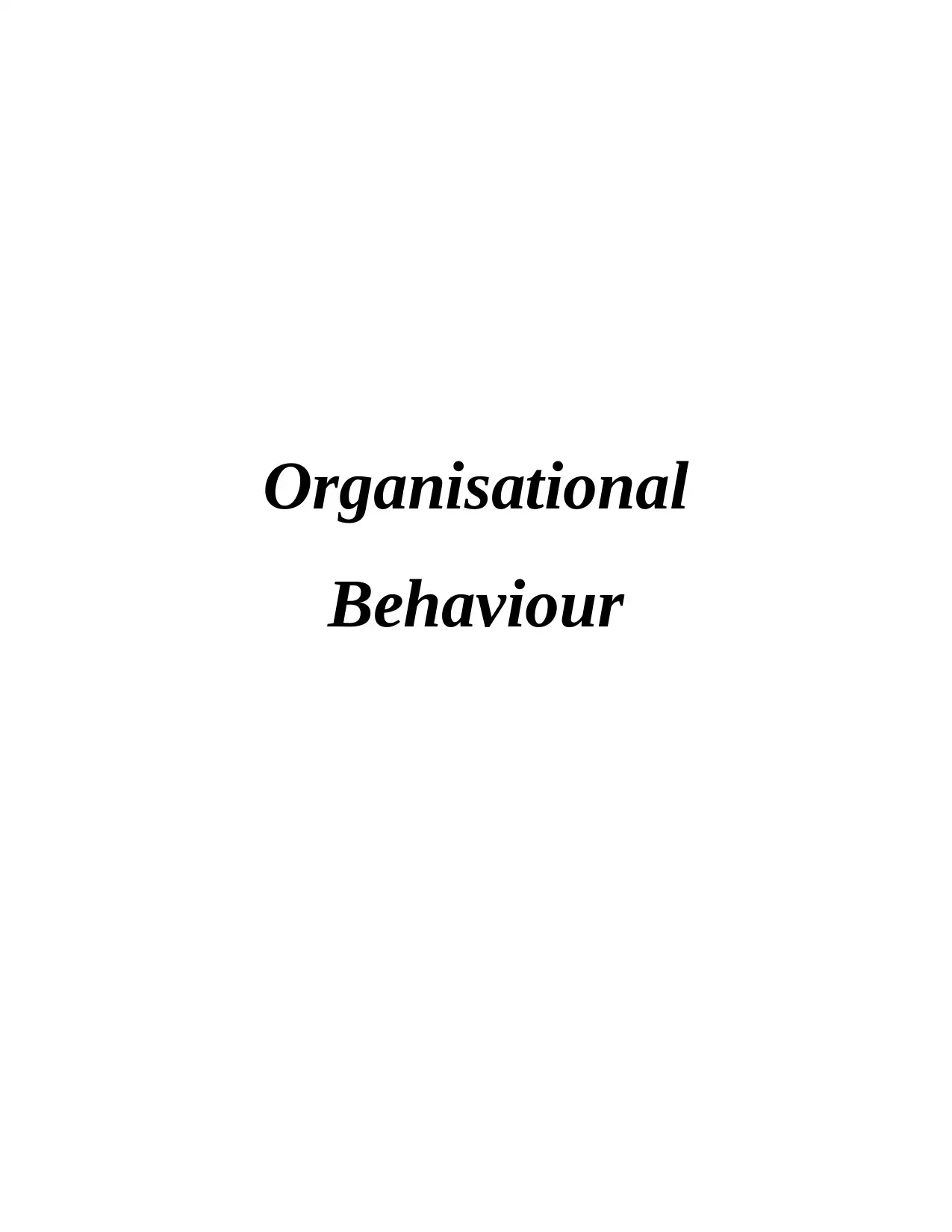
Organisational
Behaviour
Behaviour
Paraphrase This Document
Need a fresh take? Get an instant paraphrase of this document with our AI Paraphraser
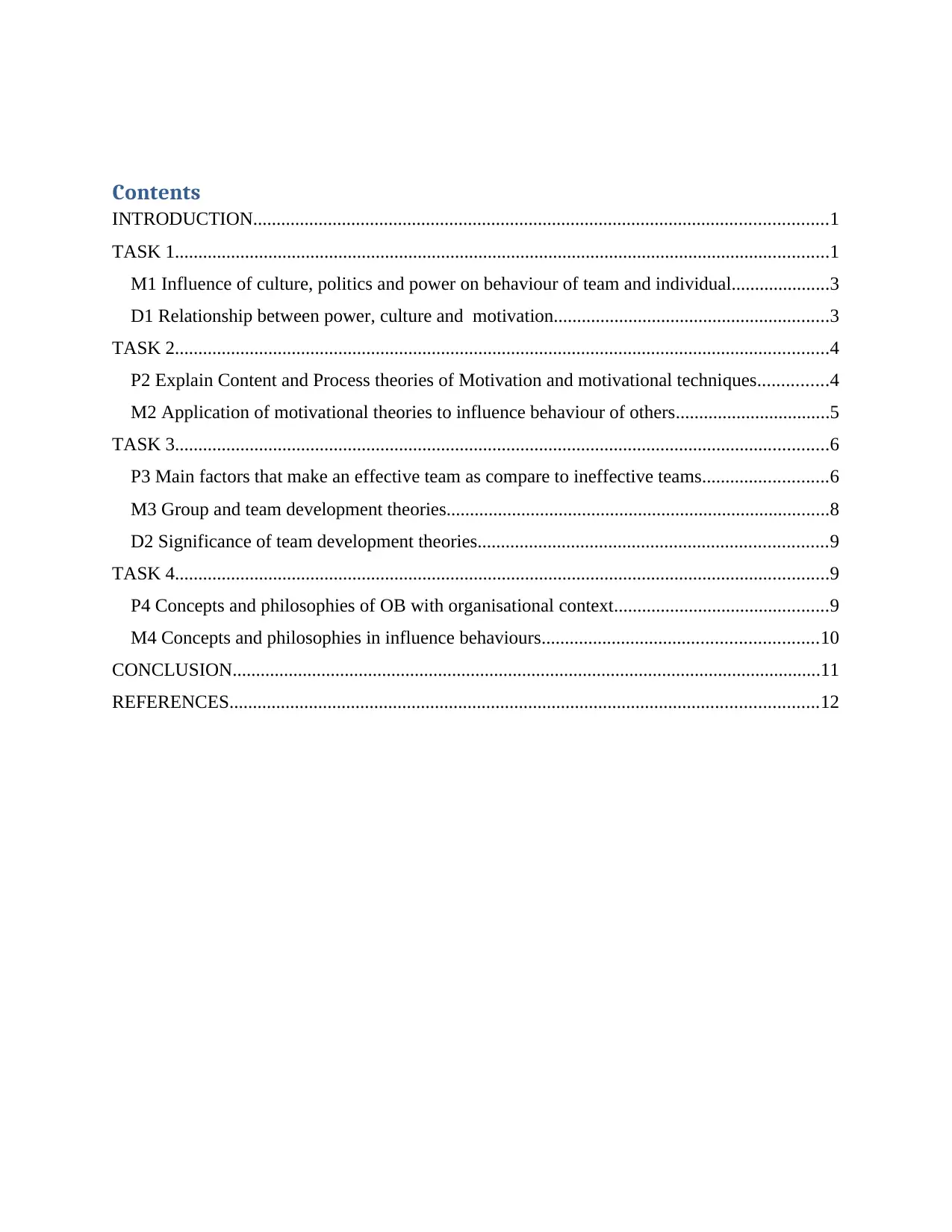
Contents
INTRODUCTION...........................................................................................................................1
TASK 1............................................................................................................................................1
M1 Influence of culture, politics and power on behaviour of team and individual.....................3
D1 Relationship between power, culture and motivation...........................................................3
TASK 2............................................................................................................................................4
P2 Explain Content and Process theories of Motivation and motivational techniques...............4
M2 Application of motivational theories to influence behaviour of others.................................5
TASK 3............................................................................................................................................6
P3 Main factors that make an effective team as compare to ineffective teams...........................6
M3 Group and team development theories..................................................................................8
D2 Significance of team development theories...........................................................................9
TASK 4............................................................................................................................................9
P4 Concepts and philosophies of OB with organisational context..............................................9
M4 Concepts and philosophies in influence behaviours...........................................................10
CONCLUSION..............................................................................................................................11
REFERENCES..............................................................................................................................12
INTRODUCTION...........................................................................................................................1
TASK 1............................................................................................................................................1
M1 Influence of culture, politics and power on behaviour of team and individual.....................3
D1 Relationship between power, culture and motivation...........................................................3
TASK 2............................................................................................................................................4
P2 Explain Content and Process theories of Motivation and motivational techniques...............4
M2 Application of motivational theories to influence behaviour of others.................................5
TASK 3............................................................................................................................................6
P3 Main factors that make an effective team as compare to ineffective teams...........................6
M3 Group and team development theories..................................................................................8
D2 Significance of team development theories...........................................................................9
TASK 4............................................................................................................................................9
P4 Concepts and philosophies of OB with organisational context..............................................9
M4 Concepts and philosophies in influence behaviours...........................................................10
CONCLUSION..............................................................................................................................11
REFERENCES..............................................................................................................................12

⊘ This is a preview!⊘
Do you want full access?
Subscribe today to unlock all pages.

Trusted by 1+ million students worldwide
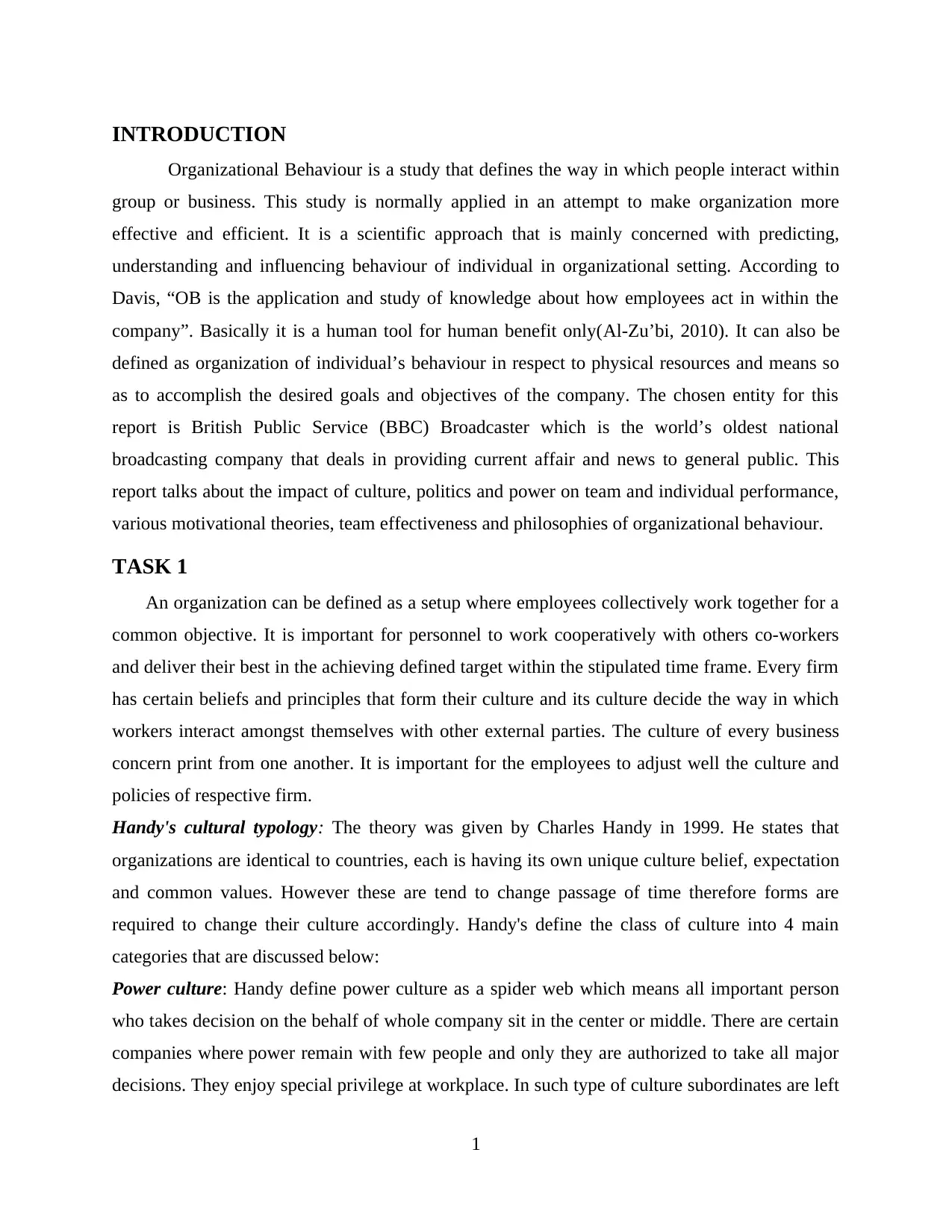
INTRODUCTION
Organizational Behaviour is a study that defines the way in which people interact within
group or business. This study is normally applied in an attempt to make organization more
effective and efficient. It is a scientific approach that is mainly concerned with predicting,
understanding and influencing behaviour of individual in organizational setting. According to
Davis, “OB is the application and study of knowledge about how employees act in within the
company”. Basically it is a human tool for human benefit only(Al-Zu’bi, 2010). It can also be
defined as organization of individual’s behaviour in respect to physical resources and means so
as to accomplish the desired goals and objectives of the company. The chosen entity for this
report is British Public Service (BBC) Broadcaster which is the world’s oldest national
broadcasting company that deals in providing current affair and news to general public. This
report talks about the impact of culture, politics and power on team and individual performance,
various motivational theories, team effectiveness and philosophies of organizational behaviour.
TASK 1
An organization can be defined as a setup where employees collectively work together for a
common objective. It is important for personnel to work cooperatively with others co-workers
and deliver their best in the achieving defined target within the stipulated time frame. Every firm
has certain beliefs and principles that form their culture and its culture decide the way in which
workers interact amongst themselves with other external parties. The culture of every business
concern print from one another. It is important for the employees to adjust well the culture and
policies of respective firm.
Handy's cultural typology: The theory was given by Charles Handy in 1999. He states that
organizations are identical to countries, each is having its own unique culture belief, expectation
and common values. However these are tend to change passage of time therefore forms are
required to change their culture accordingly. Handy's define the class of culture into 4 main
categories that are discussed below:
Power culture: Handy define power culture as a spider web which means all important person
who takes decision on the behalf of whole company sit in the center or middle. There are certain
companies where power remain with few people and only they are authorized to take all major
decisions. They enjoy special privilege at workplace. In such type of culture subordinates are left
1
Organizational Behaviour is a study that defines the way in which people interact within
group or business. This study is normally applied in an attempt to make organization more
effective and efficient. It is a scientific approach that is mainly concerned with predicting,
understanding and influencing behaviour of individual in organizational setting. According to
Davis, “OB is the application and study of knowledge about how employees act in within the
company”. Basically it is a human tool for human benefit only(Al-Zu’bi, 2010). It can also be
defined as organization of individual’s behaviour in respect to physical resources and means so
as to accomplish the desired goals and objectives of the company. The chosen entity for this
report is British Public Service (BBC) Broadcaster which is the world’s oldest national
broadcasting company that deals in providing current affair and news to general public. This
report talks about the impact of culture, politics and power on team and individual performance,
various motivational theories, team effectiveness and philosophies of organizational behaviour.
TASK 1
An organization can be defined as a setup where employees collectively work together for a
common objective. It is important for personnel to work cooperatively with others co-workers
and deliver their best in the achieving defined target within the stipulated time frame. Every firm
has certain beliefs and principles that form their culture and its culture decide the way in which
workers interact amongst themselves with other external parties. The culture of every business
concern print from one another. It is important for the employees to adjust well the culture and
policies of respective firm.
Handy's cultural typology: The theory was given by Charles Handy in 1999. He states that
organizations are identical to countries, each is having its own unique culture belief, expectation
and common values. However these are tend to change passage of time therefore forms are
required to change their culture accordingly. Handy's define the class of culture into 4 main
categories that are discussed below:
Power culture: Handy define power culture as a spider web which means all important person
who takes decision on the behalf of whole company sit in the center or middle. There are certain
companies where power remain with few people and only they are authorized to take all major
decisions. They enjoy special privilege at workplace. In such type of culture subordinates are left
1
Paraphrase This Document
Need a fresh take? Get an instant paraphrase of this document with our AI Paraphraser
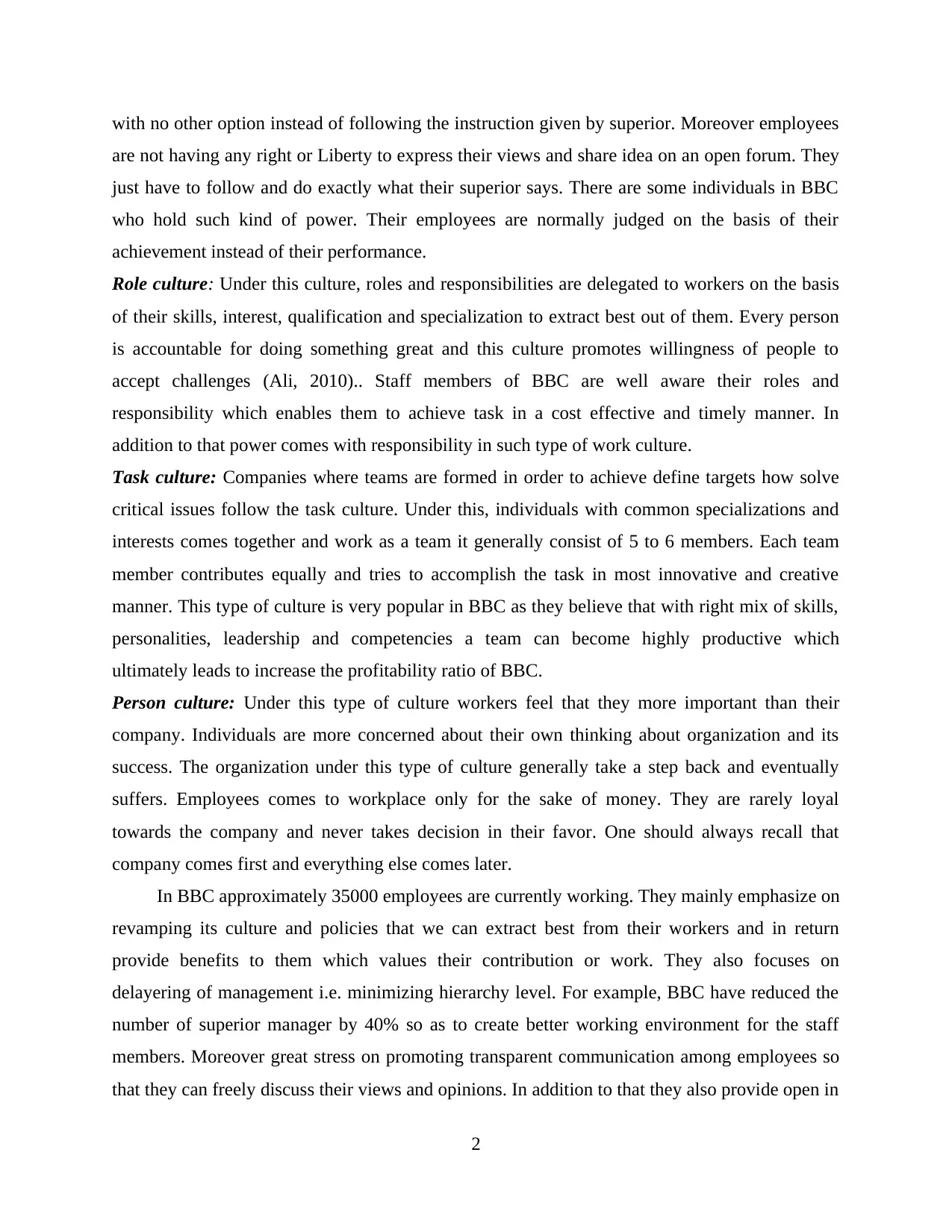
with no other option instead of following the instruction given by superior. Moreover employees
are not having any right or Liberty to express their views and share idea on an open forum. They
just have to follow and do exactly what their superior says. There are some individuals in BBC
who hold such kind of power. Their employees are normally judged on the basis of their
achievement instead of their performance.
Role culture: Under this culture, roles and responsibilities are delegated to workers on the basis
of their skills, interest, qualification and specialization to extract best out of them. Every person
is accountable for doing something great and this culture promotes willingness of people to
accept challenges (Ali, 2010).. Staff members of BBC are well aware their roles and
responsibility which enables them to achieve task in a cost effective and timely manner. In
addition to that power comes with responsibility in such type of work culture.
Task culture: Companies where teams are formed in order to achieve define targets how solve
critical issues follow the task culture. Under this, individuals with common specializations and
interests comes together and work as a team it generally consist of 5 to 6 members. Each team
member contributes equally and tries to accomplish the task in most innovative and creative
manner. This type of culture is very popular in BBC as they believe that with right mix of skills,
personalities, leadership and competencies a team can become highly productive which
ultimately leads to increase the profitability ratio of BBC.
Person culture: Under this type of culture workers feel that they more important than their
company. Individuals are more concerned about their own thinking about organization and its
success. The organization under this type of culture generally take a step back and eventually
suffers. Employees comes to workplace only for the sake of money. They are rarely loyal
towards the company and never takes decision in their favor. One should always recall that
company comes first and everything else comes later.
In BBC approximately 35000 employees are currently working. They mainly emphasize on
revamping its culture and policies that we can extract best from their workers and in return
provide benefits to them which values their contribution or work. They also focuses on
delayering of management i.e. minimizing hierarchy level. For example, BBC have reduced the
number of superior manager by 40% so as to create better working environment for the staff
members. Moreover great stress on promoting transparent communication among employees so
that they can freely discuss their views and opinions. In addition to that they also provide open in
2
are not having any right or Liberty to express their views and share idea on an open forum. They
just have to follow and do exactly what their superior says. There are some individuals in BBC
who hold such kind of power. Their employees are normally judged on the basis of their
achievement instead of their performance.
Role culture: Under this culture, roles and responsibilities are delegated to workers on the basis
of their skills, interest, qualification and specialization to extract best out of them. Every person
is accountable for doing something great and this culture promotes willingness of people to
accept challenges (Ali, 2010).. Staff members of BBC are well aware their roles and
responsibility which enables them to achieve task in a cost effective and timely manner. In
addition to that power comes with responsibility in such type of work culture.
Task culture: Companies where teams are formed in order to achieve define targets how solve
critical issues follow the task culture. Under this, individuals with common specializations and
interests comes together and work as a team it generally consist of 5 to 6 members. Each team
member contributes equally and tries to accomplish the task in most innovative and creative
manner. This type of culture is very popular in BBC as they believe that with right mix of skills,
personalities, leadership and competencies a team can become highly productive which
ultimately leads to increase the profitability ratio of BBC.
Person culture: Under this type of culture workers feel that they more important than their
company. Individuals are more concerned about their own thinking about organization and its
success. The organization under this type of culture generally take a step back and eventually
suffers. Employees comes to workplace only for the sake of money. They are rarely loyal
towards the company and never takes decision in their favor. One should always recall that
company comes first and everything else comes later.
In BBC approximately 35000 employees are currently working. They mainly emphasize on
revamping its culture and policies that we can extract best from their workers and in return
provide benefits to them which values their contribution or work. They also focuses on
delayering of management i.e. minimizing hierarchy level. For example, BBC have reduced the
number of superior manager by 40% so as to create better working environment for the staff
members. Moreover great stress on promoting transparent communication among employees so
that they can freely discuss their views and opinions. In addition to that they also provide open in
2
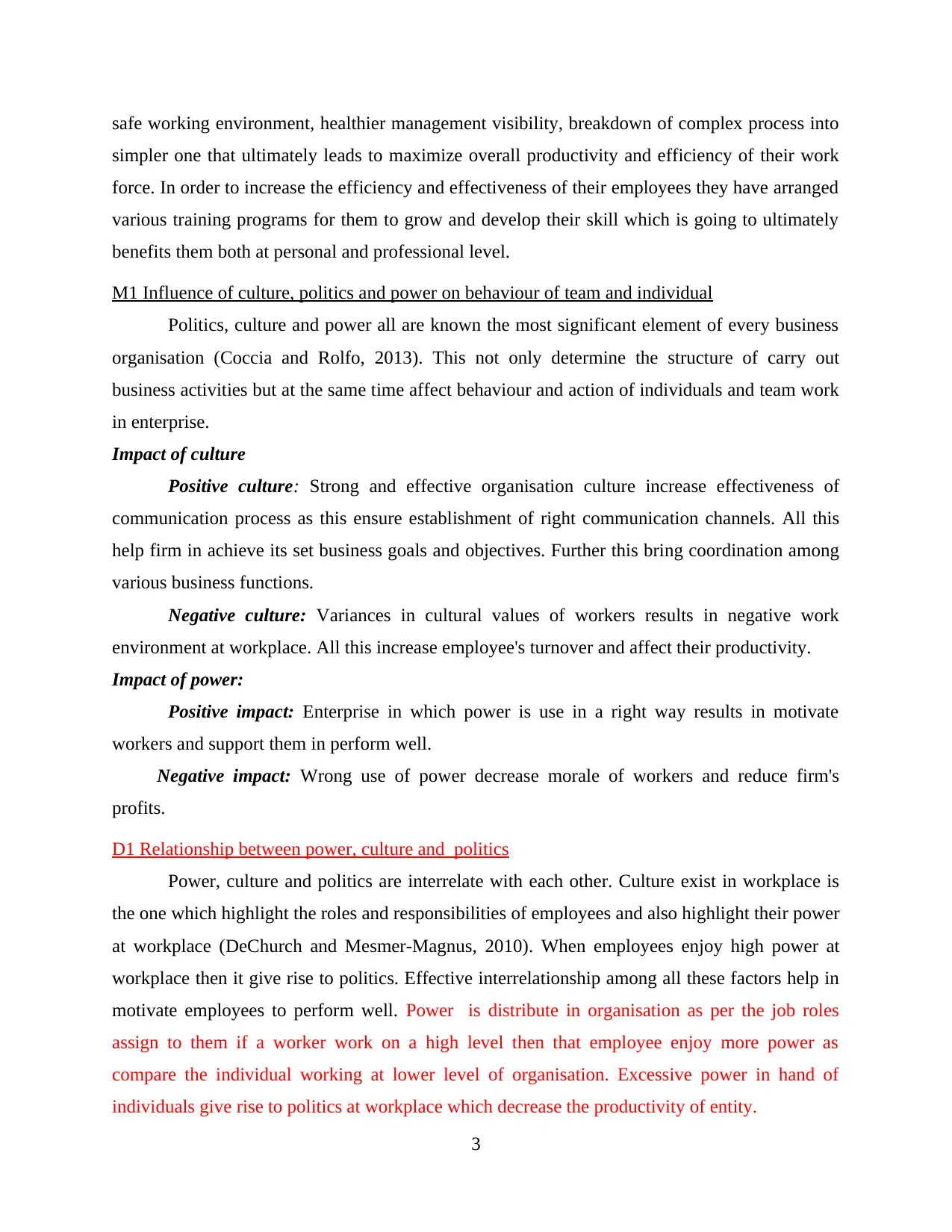
safe working environment, healthier management visibility, breakdown of complex process into
simpler one that ultimately leads to maximize overall productivity and efficiency of their work
force. In order to increase the efficiency and effectiveness of their employees they have arranged
various training programs for them to grow and develop their skill which is going to ultimately
benefits them both at personal and professional level.
M1 Influence of culture, politics and power on behaviour of team and individual
Politics, culture and power all are known the most significant element of every business
organisation (Coccia and Rolfo, 2013). This not only determine the structure of carry out
business activities but at the same time affect behaviour and action of individuals and team work
in enterprise.
Impact of culture
Positive culture: Strong and effective organisation culture increase effectiveness of
communication process as this ensure establishment of right communication channels. All this
help firm in achieve its set business goals and objectives. Further this bring coordination among
various business functions.
Negative culture: Variances in cultural values of workers results in negative work
environment at workplace. All this increase employee's turnover and affect their productivity.
Impact of power:
Positive impact: Enterprise in which power is use in a right way results in motivate
workers and support them in perform well.
Negative impact: Wrong use of power decrease morale of workers and reduce firm's
profits.
D1 Relationship between power, culture and politics
Power, culture and politics are interrelate with each other. Culture exist in workplace is
the one which highlight the roles and responsibilities of employees and also highlight their power
at workplace (DeChurch and Mesmer-Magnus, 2010). When employees enjoy high power at
workplace then it give rise to politics. Effective interrelationship among all these factors help in
motivate employees to perform well. Power is distribute in organisation as per the job roles
assign to them if a worker work on a high level then that employee enjoy more power as
compare the individual working at lower level of organisation. Excessive power in hand of
individuals give rise to politics at workplace which decrease the productivity of entity.
3
simpler one that ultimately leads to maximize overall productivity and efficiency of their work
force. In order to increase the efficiency and effectiveness of their employees they have arranged
various training programs for them to grow and develop their skill which is going to ultimately
benefits them both at personal and professional level.
M1 Influence of culture, politics and power on behaviour of team and individual
Politics, culture and power all are known the most significant element of every business
organisation (Coccia and Rolfo, 2013). This not only determine the structure of carry out
business activities but at the same time affect behaviour and action of individuals and team work
in enterprise.
Impact of culture
Positive culture: Strong and effective organisation culture increase effectiveness of
communication process as this ensure establishment of right communication channels. All this
help firm in achieve its set business goals and objectives. Further this bring coordination among
various business functions.
Negative culture: Variances in cultural values of workers results in negative work
environment at workplace. All this increase employee's turnover and affect their productivity.
Impact of power:
Positive impact: Enterprise in which power is use in a right way results in motivate
workers and support them in perform well.
Negative impact: Wrong use of power decrease morale of workers and reduce firm's
profits.
D1 Relationship between power, culture and politics
Power, culture and politics are interrelate with each other. Culture exist in workplace is
the one which highlight the roles and responsibilities of employees and also highlight their power
at workplace (DeChurch and Mesmer-Magnus, 2010). When employees enjoy high power at
workplace then it give rise to politics. Effective interrelationship among all these factors help in
motivate employees to perform well. Power is distribute in organisation as per the job roles
assign to them if a worker work on a high level then that employee enjoy more power as
compare the individual working at lower level of organisation. Excessive power in hand of
individuals give rise to politics at workplace which decrease the productivity of entity.
3
⊘ This is a preview!⊘
Do you want full access?
Subscribe today to unlock all pages.

Trusted by 1+ million students worldwide
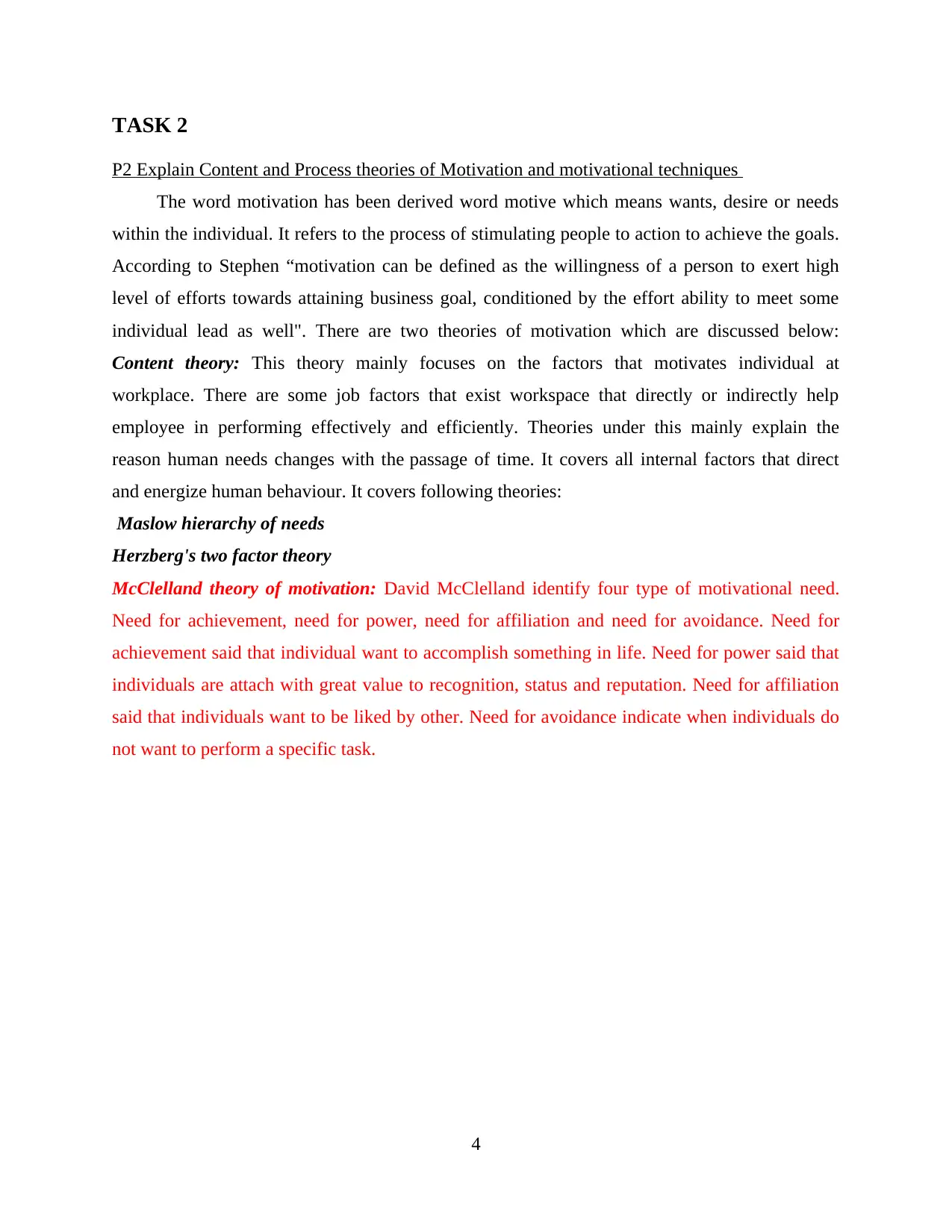
TASK 2
P2 Explain Content and Process theories of Motivation and motivational techniques
The word motivation has been derived word motive which means wants, desire or needs
within the individual. It refers to the process of stimulating people to action to achieve the goals.
According to Stephen “motivation can be defined as the willingness of a person to exert high
level of efforts towards attaining business goal, conditioned by the effort ability to meet some
individual lead as well". There are two theories of motivation which are discussed below:
Content theory: This theory mainly focuses on the factors that motivates individual at
workplace. There are some job factors that exist workspace that directly or indirectly help
employee in performing effectively and efficiently. Theories under this mainly explain the
reason human needs changes with the passage of time. It covers all internal factors that direct
and energize human behaviour. It covers following theories:
Maslow hierarchy of needs
Herzberg's two factor theory
McClelland theory of motivation: David McClelland identify four type of motivational need.
Need for achievement, need for power, need for affiliation and need for avoidance. Need for
achievement said that individual want to accomplish something in life. Need for power said that
individuals are attach with great value to recognition, status and reputation. Need for affiliation
said that individuals want to be liked by other. Need for avoidance indicate when individuals do
not want to perform a specific task.
4
P2 Explain Content and Process theories of Motivation and motivational techniques
The word motivation has been derived word motive which means wants, desire or needs
within the individual. It refers to the process of stimulating people to action to achieve the goals.
According to Stephen “motivation can be defined as the willingness of a person to exert high
level of efforts towards attaining business goal, conditioned by the effort ability to meet some
individual lead as well". There are two theories of motivation which are discussed below:
Content theory: This theory mainly focuses on the factors that motivates individual at
workplace. There are some job factors that exist workspace that directly or indirectly help
employee in performing effectively and efficiently. Theories under this mainly explain the
reason human needs changes with the passage of time. It covers all internal factors that direct
and energize human behaviour. It covers following theories:
Maslow hierarchy of needs
Herzberg's two factor theory
McClelland theory of motivation: David McClelland identify four type of motivational need.
Need for achievement, need for power, need for affiliation and need for avoidance. Need for
achievement said that individual want to accomplish something in life. Need for power said that
individuals are attach with great value to recognition, status and reputation. Need for affiliation
said that individuals want to be liked by other. Need for avoidance indicate when individuals do
not want to perform a specific task.
4
Paraphrase This Document
Need a fresh take? Get an instant paraphrase of this document with our AI Paraphraser
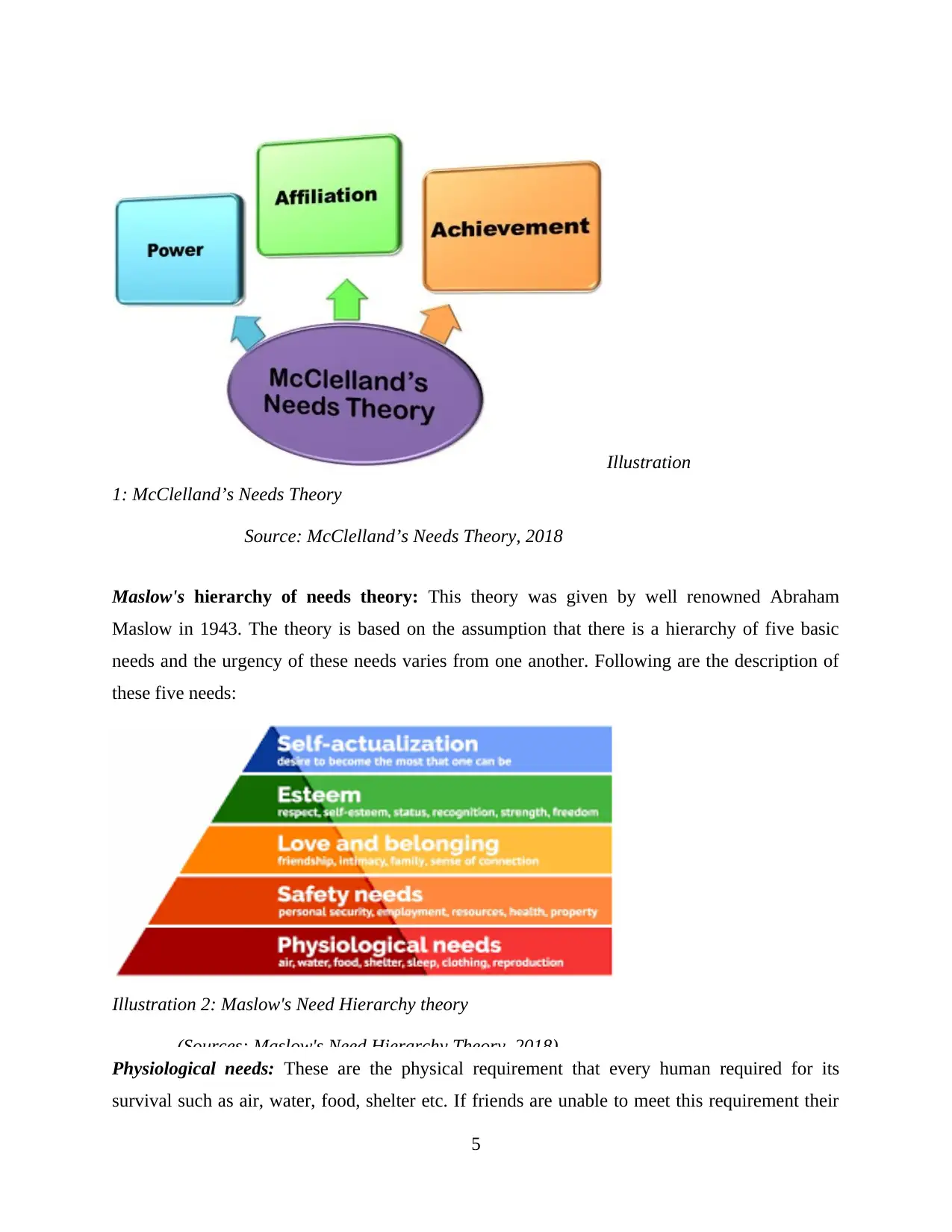
Illustration
1: McClelland’s Needs Theory
Source: McClelland’s Needs Theory, 2018
Maslow's hierarchy of needs theory: This theory was given by well renowned Abraham
Maslow in 1943. The theory is based on the assumption that there is a hierarchy of five basic
needs and the urgency of these needs varies from one another. Following are the description of
these five needs:
Illustration 2: Maslow's Need Hierarchy theory
(Sources: Maslow's Need Hierarchy Theory, 2018)
Physiological needs: These are the physical requirement that every human required for its
survival such as air, water, food, shelter etc. If friends are unable to meet this requirement their
5
1: McClelland’s Needs Theory
Source: McClelland’s Needs Theory, 2018
Maslow's hierarchy of needs theory: This theory was given by well renowned Abraham
Maslow in 1943. The theory is based on the assumption that there is a hierarchy of five basic
needs and the urgency of these needs varies from one another. Following are the description of
these five needs:
Illustration 2: Maslow's Need Hierarchy theory
(Sources: Maslow's Need Hierarchy Theory, 2018)
Physiological needs: These are the physical requirement that every human required for its
survival such as air, water, food, shelter etc. If friends are unable to meet this requirement their
5
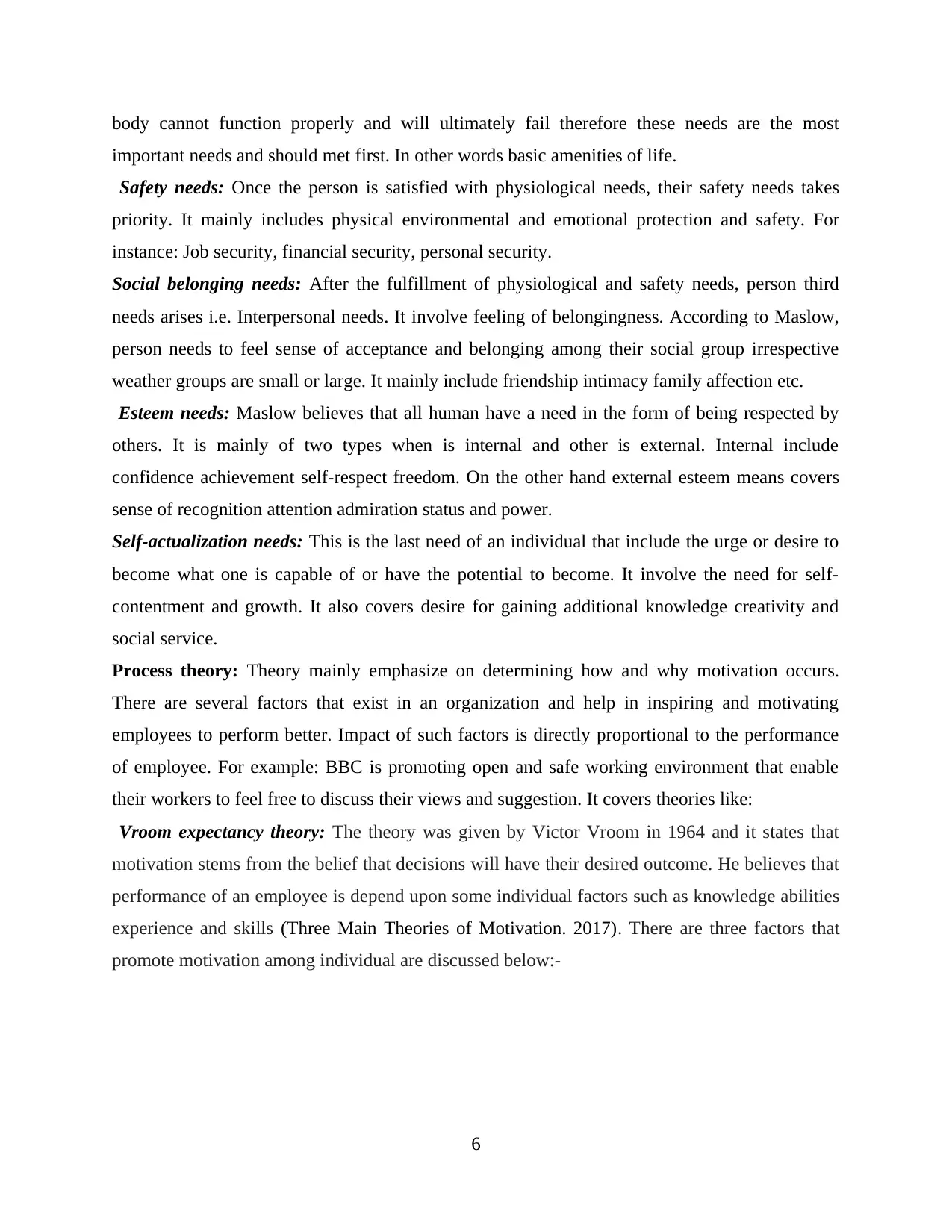
body cannot function properly and will ultimately fail therefore these needs are the most
important needs and should met first. In other words basic amenities of life.
Safety needs: Once the person is satisfied with physiological needs, their safety needs takes
priority. It mainly includes physical environmental and emotional protection and safety. For
instance: Job security, financial security, personal security.
Social belonging needs: After the fulfillment of physiological and safety needs, person third
needs arises i.e. Interpersonal needs. It involve feeling of belongingness. According to Maslow,
person needs to feel sense of acceptance and belonging among their social group irrespective
weather groups are small or large. It mainly include friendship intimacy family affection etc.
Esteem needs: Maslow believes that all human have a need in the form of being respected by
others. It is mainly of two types when is internal and other is external. Internal include
confidence achievement self-respect freedom. On the other hand external esteem means covers
sense of recognition attention admiration status and power.
Self-actualization needs: This is the last need of an individual that include the urge or desire to
become what one is capable of or have the potential to become. It involve the need for self-
contentment and growth. It also covers desire for gaining additional knowledge creativity and
social service.
Process theory: Theory mainly emphasize on determining how and why motivation occurs.
There are several factors that exist in an organization and help in inspiring and motivating
employees to perform better. Impact of such factors is directly proportional to the performance
of employee. For example: BBC is promoting open and safe working environment that enable
their workers to feel free to discuss their views and suggestion. It covers theories like:
Vroom expectancy theory: The theory was given by Victor Vroom in 1964 and it states that
motivation stems from the belief that decisions will have their desired outcome. He believes that
performance of an employee is depend upon some individual factors such as knowledge abilities
experience and skills (Three Main Theories of Motivation. 2017). There are three factors that
promote motivation among individual are discussed below:-
6
important needs and should met first. In other words basic amenities of life.
Safety needs: Once the person is satisfied with physiological needs, their safety needs takes
priority. It mainly includes physical environmental and emotional protection and safety. For
instance: Job security, financial security, personal security.
Social belonging needs: After the fulfillment of physiological and safety needs, person third
needs arises i.e. Interpersonal needs. It involve feeling of belongingness. According to Maslow,
person needs to feel sense of acceptance and belonging among their social group irrespective
weather groups are small or large. It mainly include friendship intimacy family affection etc.
Esteem needs: Maslow believes that all human have a need in the form of being respected by
others. It is mainly of two types when is internal and other is external. Internal include
confidence achievement self-respect freedom. On the other hand external esteem means covers
sense of recognition attention admiration status and power.
Self-actualization needs: This is the last need of an individual that include the urge or desire to
become what one is capable of or have the potential to become. It involve the need for self-
contentment and growth. It also covers desire for gaining additional knowledge creativity and
social service.
Process theory: Theory mainly emphasize on determining how and why motivation occurs.
There are several factors that exist in an organization and help in inspiring and motivating
employees to perform better. Impact of such factors is directly proportional to the performance
of employee. For example: BBC is promoting open and safe working environment that enable
their workers to feel free to discuss their views and suggestion. It covers theories like:
Vroom expectancy theory: The theory was given by Victor Vroom in 1964 and it states that
motivation stems from the belief that decisions will have their desired outcome. He believes that
performance of an employee is depend upon some individual factors such as knowledge abilities
experience and skills (Three Main Theories of Motivation. 2017). There are three factors that
promote motivation among individual are discussed below:-
6
⊘ This is a preview!⊘
Do you want full access?
Subscribe today to unlock all pages.

Trusted by 1+ million students worldwide
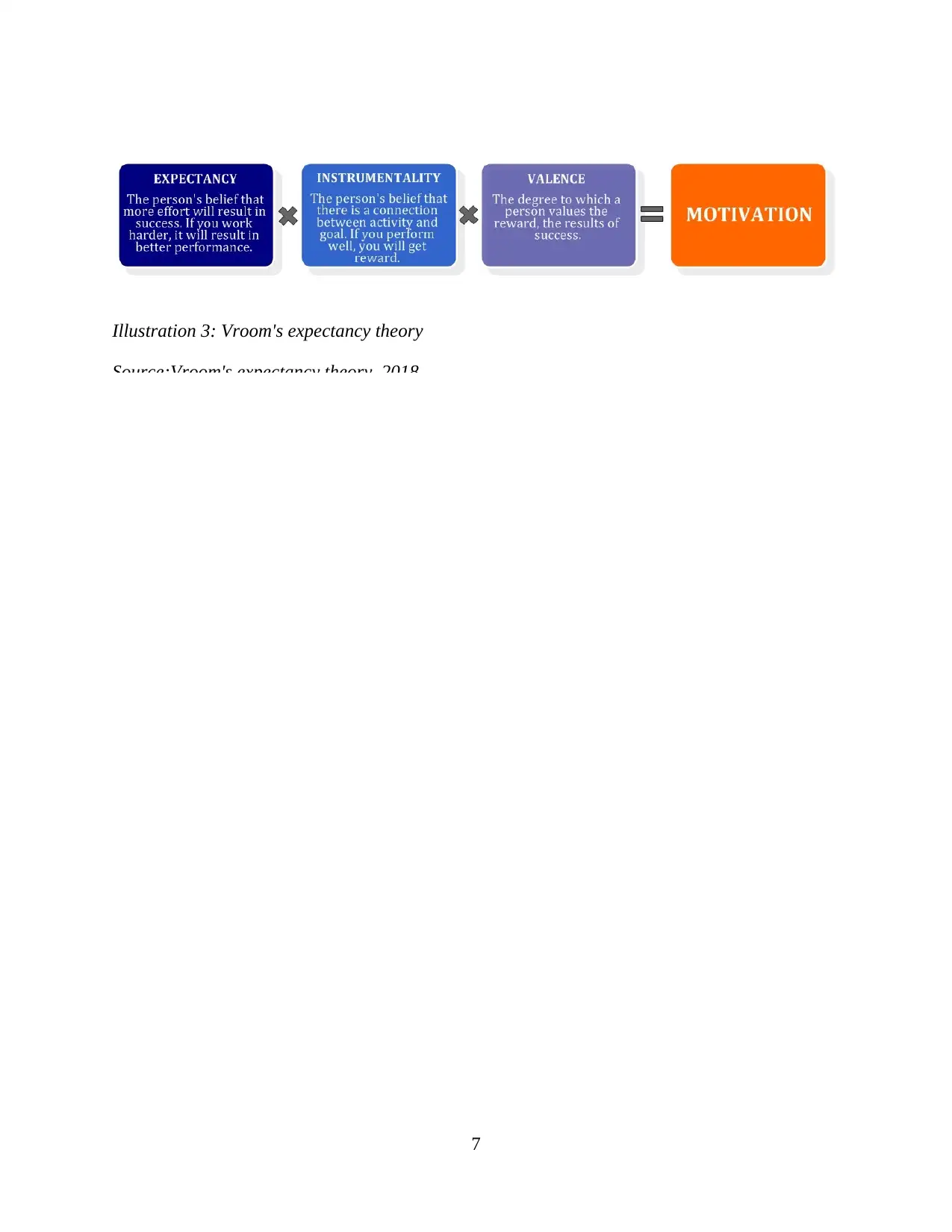
7
Illustration 3: Vroom's expectancy theory
Source:Vroom's expectancy theory, 2018
Illustration 3: Vroom's expectancy theory
Source:Vroom's expectancy theory, 2018
Paraphrase This Document
Need a fresh take? Get an instant paraphrase of this document with our AI Paraphraser
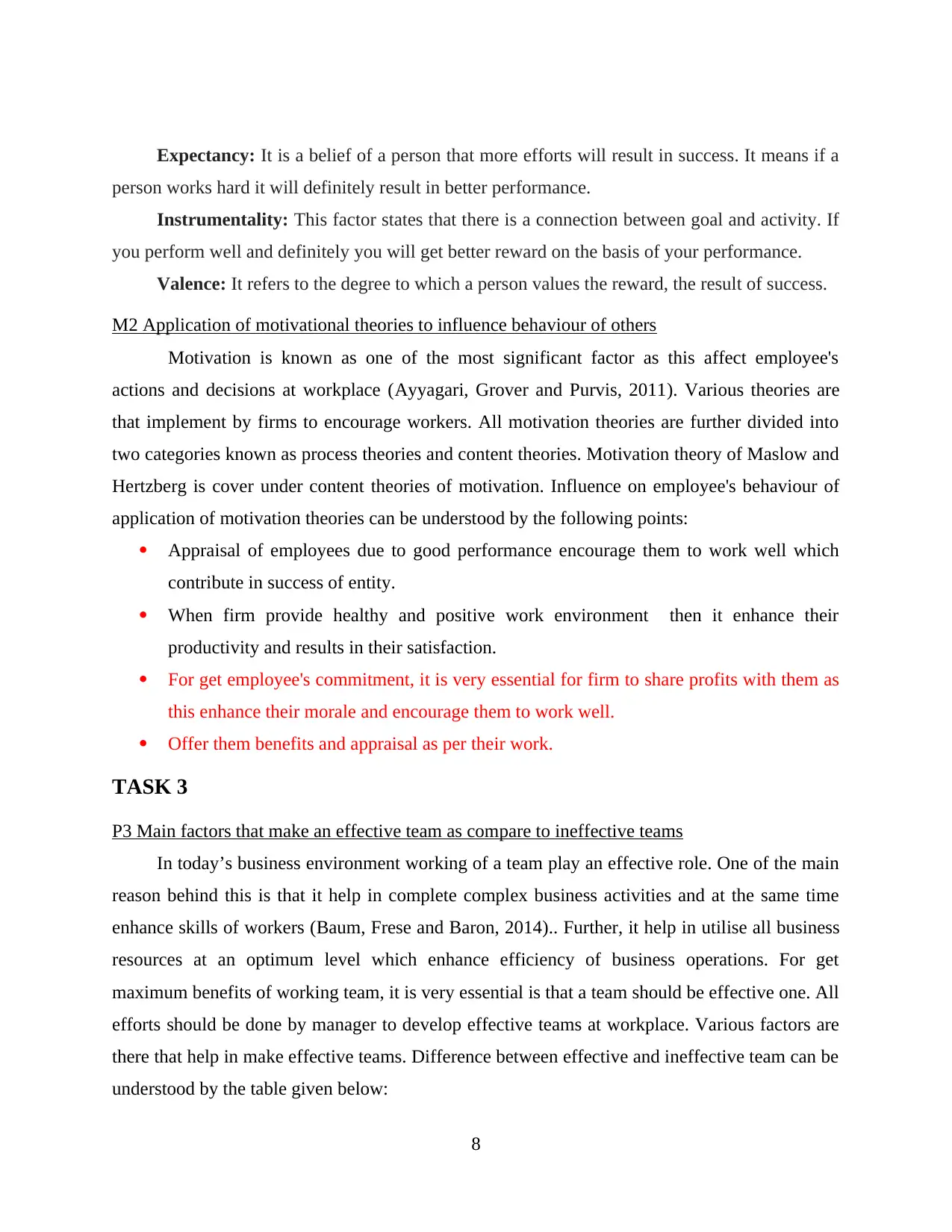
Expectancy: It is a belief of a person that more efforts will result in success. It means if a
person works hard it will definitely result in better performance.
Instrumentality: This factor states that there is a connection between goal and activity. If
you perform well and definitely you will get better reward on the basis of your performance.
Valence: It refers to the degree to which a person values the reward, the result of success.
M2 Application of motivational theories to influence behaviour of others
Motivation is known as one of the most significant factor as this affect employee's
actions and decisions at workplace (Ayyagari, Grover and Purvis, 2011). Various theories are
that implement by firms to encourage workers. All motivation theories are further divided into
two categories known as process theories and content theories. Motivation theory of Maslow and
Hertzberg is cover under content theories of motivation. Influence on employee's behaviour of
application of motivation theories can be understood by the following points:
Appraisal of employees due to good performance encourage them to work well which
contribute in success of entity.
When firm provide healthy and positive work environment then it enhance their
productivity and results in their satisfaction.
For get employee's commitment, it is very essential for firm to share profits with them as
this enhance their morale and encourage them to work well.
Offer them benefits and appraisal as per their work.
TASK 3
P3 Main factors that make an effective team as compare to ineffective teams
In today’s business environment working of a team play an effective role. One of the main
reason behind this is that it help in complete complex business activities and at the same time
enhance skills of workers (Baum, Frese and Baron, 2014).. Further, it help in utilise all business
resources at an optimum level which enhance efficiency of business operations. For get
maximum benefits of working team, it is very essential is that a team should be effective one. All
efforts should be done by manager to develop effective teams at workplace. Various factors are
there that help in make effective teams. Difference between effective and ineffective team can be
understood by the table given below:
8
person works hard it will definitely result in better performance.
Instrumentality: This factor states that there is a connection between goal and activity. If
you perform well and definitely you will get better reward on the basis of your performance.
Valence: It refers to the degree to which a person values the reward, the result of success.
M2 Application of motivational theories to influence behaviour of others
Motivation is known as one of the most significant factor as this affect employee's
actions and decisions at workplace (Ayyagari, Grover and Purvis, 2011). Various theories are
that implement by firms to encourage workers. All motivation theories are further divided into
two categories known as process theories and content theories. Motivation theory of Maslow and
Hertzberg is cover under content theories of motivation. Influence on employee's behaviour of
application of motivation theories can be understood by the following points:
Appraisal of employees due to good performance encourage them to work well which
contribute in success of entity.
When firm provide healthy and positive work environment then it enhance their
productivity and results in their satisfaction.
For get employee's commitment, it is very essential for firm to share profits with them as
this enhance their morale and encourage them to work well.
Offer them benefits and appraisal as per their work.
TASK 3
P3 Main factors that make an effective team as compare to ineffective teams
In today’s business environment working of a team play an effective role. One of the main
reason behind this is that it help in complete complex business activities and at the same time
enhance skills of workers (Baum, Frese and Baron, 2014).. Further, it help in utilise all business
resources at an optimum level which enhance efficiency of business operations. For get
maximum benefits of working team, it is very essential is that a team should be effective one. All
efforts should be done by manager to develop effective teams at workplace. Various factors are
there that help in make effective teams. Difference between effective and ineffective team can be
understood by the table given below:
8
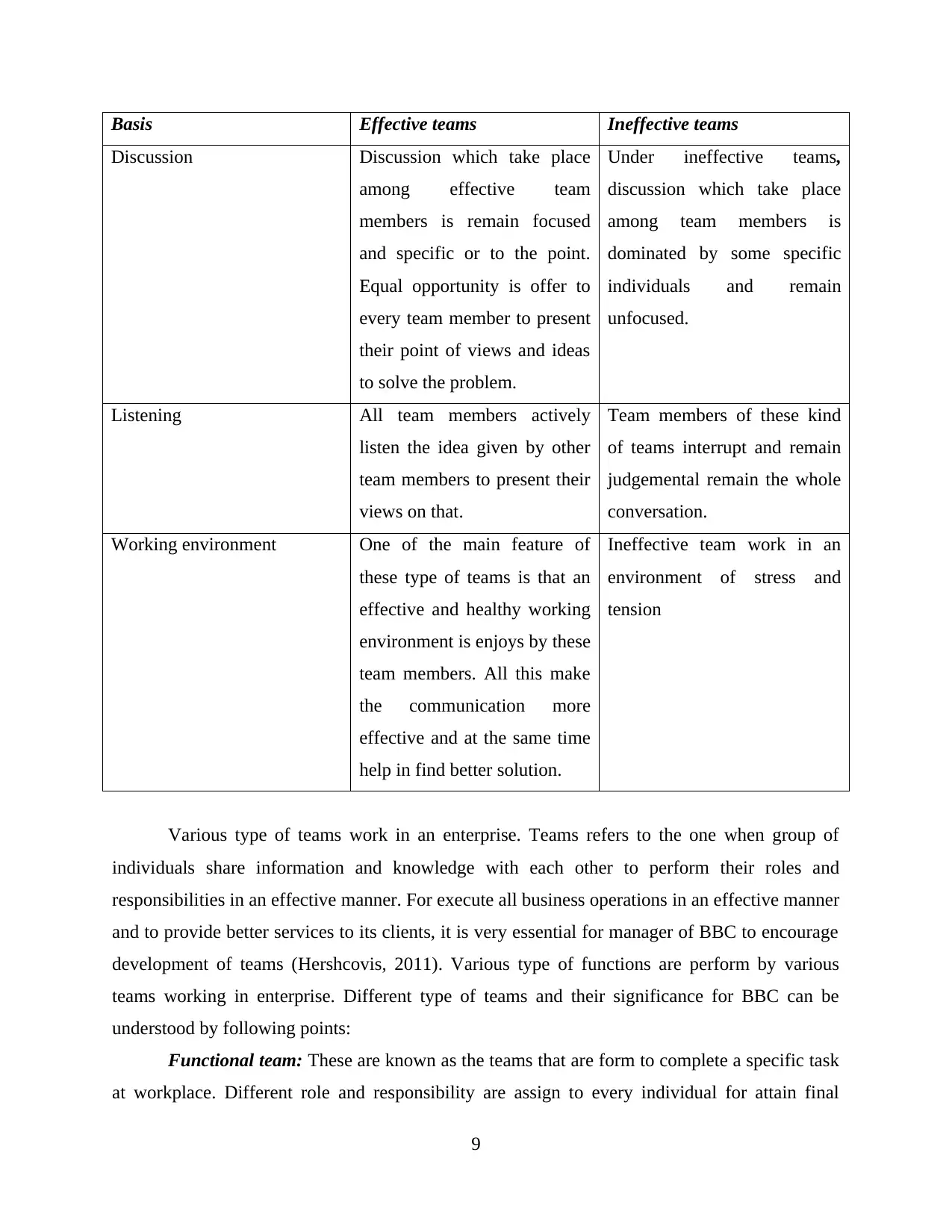
Basis Effective teams Ineffective teams
Discussion Discussion which take place
among effective team
members is remain focused
and specific or to the point.
Equal opportunity is offer to
every team member to present
their point of views and ideas
to solve the problem.
Under ineffective teams,
discussion which take place
among team members is
dominated by some specific
individuals and remain
unfocused.
Listening All team members actively
listen the idea given by other
team members to present their
views on that.
Team members of these kind
of teams interrupt and remain
judgemental remain the whole
conversation.
Working environment One of the main feature of
these type of teams is that an
effective and healthy working
environment is enjoys by these
team members. All this make
the communication more
effective and at the same time
help in find better solution.
Ineffective team work in an
environment of stress and
tension
Various type of teams work in an enterprise. Teams refers to the one when group of
individuals share information and knowledge with each other to perform their roles and
responsibilities in an effective manner. For execute all business operations in an effective manner
and to provide better services to its clients, it is very essential for manager of BBC to encourage
development of teams (Hershcovis, 2011). Various type of functions are perform by various
teams working in enterprise. Different type of teams and their significance for BBC can be
understood by following points:
Functional team: These are known as the teams that are form to complete a specific task
at workplace. Different role and responsibility are assign to every individual for attain final
9
Discussion Discussion which take place
among effective team
members is remain focused
and specific or to the point.
Equal opportunity is offer to
every team member to present
their point of views and ideas
to solve the problem.
Under ineffective teams,
discussion which take place
among team members is
dominated by some specific
individuals and remain
unfocused.
Listening All team members actively
listen the idea given by other
team members to present their
views on that.
Team members of these kind
of teams interrupt and remain
judgemental remain the whole
conversation.
Working environment One of the main feature of
these type of teams is that an
effective and healthy working
environment is enjoys by these
team members. All this make
the communication more
effective and at the same time
help in find better solution.
Ineffective team work in an
environment of stress and
tension
Various type of teams work in an enterprise. Teams refers to the one when group of
individuals share information and knowledge with each other to perform their roles and
responsibilities in an effective manner. For execute all business operations in an effective manner
and to provide better services to its clients, it is very essential for manager of BBC to encourage
development of teams (Hershcovis, 2011). Various type of functions are perform by various
teams working in enterprise. Different type of teams and their significance for BBC can be
understood by following points:
Functional team: These are known as the teams that are form to complete a specific task
at workplace. Different role and responsibility are assign to every individual for attain final
9
⊘ This is a preview!⊘
Do you want full access?
Subscribe today to unlock all pages.

Trusted by 1+ million students worldwide
1 out of 19
Related Documents
Your All-in-One AI-Powered Toolkit for Academic Success.
+13062052269
info@desklib.com
Available 24*7 on WhatsApp / Email
![[object Object]](/_next/static/media/star-bottom.7253800d.svg)
Unlock your academic potential
Copyright © 2020–2025 A2Z Services. All Rights Reserved. Developed and managed by ZUCOL.





